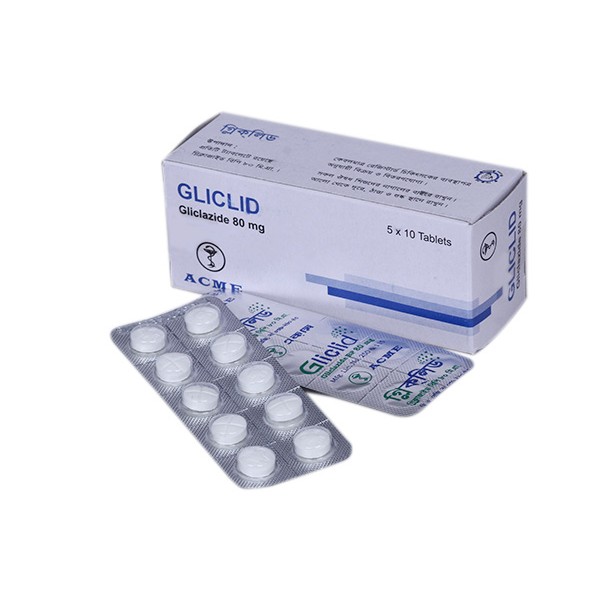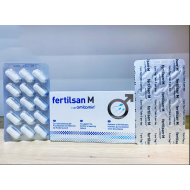
- Stock: In Stock
- Brand: Acme Laboratories Limited
- Product ID: Gliclazide
100% Secure Payment

This Item is for pre order
Gliclid 80 mg Tab
COMPOSITION
GliclidTM 80: Each tablet contains Gliclazide BP 80 mg.
GliclidTM MR: Each modified release tablet contains Gliclazide BP 30 mg.
GliclidTM 60 MR: Each modified release tablet contains Gliclazide BP 60 mg.
PHARMACOLOGY
GliclidTM (Gliclazide) is a second generation oral hypoglycemic sulphonylurea, which stimulates the release of insulin from functioning pancreatic β-cells. This is mediated by an increase in the intracellular ratio of ATP/ADP, which inhibits K+ -ATP channels. In
addition, there is evidence that Gliclazide has action on peripheral tissues. This has been shown to enhance glycogen synthesis and inhibit glycogenolysis and gluconeogenesis in the liver. This may also improve peripheral glucose uptake by muscles.
INDICATIONS
Gliclazide is indicated in non-insulin dependent diabetes (type II) when dietary modification has failed.
DOSAGE AND ADMINISTRATION
Route of administration : Oral.
Adult: The usual initial dose is 40-80 mg (1/2-1 tablet) given orally daily which may if needed gradually increased upto 320 mg daily until adequate control is achieved. A single dose should not exceed 160 mg (2 tablets). When higher doses are required, GliclidTM should be taken twice daily and according to the main meals of the day. For GliclidTM MR tablet the initial recommended dose is 30 mg daily, even in elderly patients (>65 years); the daily dose may vary from 30 mg to 120 mg taken orally. Dose titration should be carried out in steps of 30 mg, according to the fasting blood glucose response. Each step should last for at least two weeks. GliclidTM MR is a Modified release tablet and therefore, should be neither broken nor chewed.
Elderly: Plasma clearance of Gliclazide is not altered in the elderly and steady state plasma levels are similar to those in adults under 65 years. Clinical experience in the elderly shows that Gliclazide is effective and well tolerated.
Children: Gliclazide, as with other sulphonylureas is not indicated for the treatment of juvenile onset diabetes mellitus. It is recommended that the medication be taken at breakfast time. If a dose is forgotten, the dose taken on the next day should not be increased.
OR AS DIRECTED BY THE PHYSICIAN.
CONTRAINDICATIONS
Gliclazide is contraindicated in patients with known hypersensitivity to the drug. It is also contraindicated in patients with juvenile onset diabetes (type-1), diabetes associated with ketosis and acidosis, diabetic patients undergoing surgery, after severe injury or during infection.
PRECAUTIONS
Care should be exercised in patients with hepatic and renal impairment and a small starting dose should be used with careful patient monitoring. It has been suggested that
Gliclazide may be suitable for use in patients with renal impairment, but careful monitoring of blood-sugar concentration is essential.
SIDE EFFECTS
Common : As with other sulphonylureas, hypoglycemia will occur if the patients dietary intake is reduced or if they are receiving a larger dose of Gliclazide than required.
Rare : Mild gastro-intestinal disturbances including nausea, dyspepsia, diarrhea and constipation have been reported, but these type of adverse reaction can be avoided if
Gliclazide is taken during a meal.
USE IN PREGNANCY AND LACTATION
Pregnancy : Gliclazide, as other sulphonylureas, is contraindicated for use in pregnant women.
Lactation : It has not yet been established whether Gliclazide is transferred to human milk. However, other sulphonylureas have been found in milk, there is no evidence to suggest that Gliclazide differs from the group in this respect. Therefore, if use is deemed essential, the patient should stop nursing.
DRUG INTERACTIONS
With Medicine : The hypoglycemic effects of Gliclazide may be increased by Aspirin,
NSAIDs, Phenylbutazone, Clofibrate, sulfonamide, Cemetidine, Imidazole antifungal agents and Monoamino Oxidase Inhibitors. The hypoglycemic effect of Gliclazide sometimes may be reduced by Rifampin, Barbiturates, Phenytoin, Thiazide diuretics,
Diazoxide, Glucocorticoids, Estrogens, Sympathomymetic drugs and occasionally alcohol.
With food : There are no established drug-food interaction.
OVERDOSE
The administration of an excessive dose results in hypoglycemia (refer to warnings) which should be treated immediately by the administration of sugar. If the patient is unconscious, immediately inform a doctor and call the emergency service.
STORAGE
Keep all medicines out of reach of children. Store below 300 C and dry place, protected from light.
PACKING
GliclidTM 80 : Each box contains 5x10 tablets in blister strips.
GliclidTM MR : Each box contains 3x10 tablets in blister strips.
GliclidTM 60 MR : Each box contains 3x10 tablets in blister strips.




























%20Pvt.%20Ltd./Movicol-Oral-Powder-190x190.jpg)
